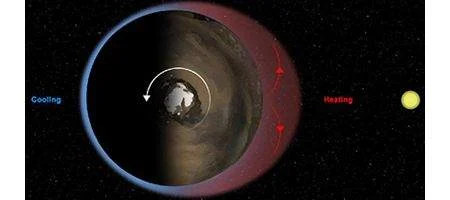NASA’s Curiosity rover has been gathering a wealth of information about winds and natural radiation on Mars, spotting whirlwinds and changes in air pressure.

Researchers have mapped winds in relation to slopes and tracked daily and seasonal changes in air pressure – information that could help scientists understand whether conditions were ever favorable for life.
In the rover’s first 12 weeks at Gale Crater, the the rover’s Environmental Monitoring Station (REMS) instrument has spotted more than 20 atmospheric events with at least one characteristic of a whirlwind.
These can include a brief dip in air pressure, a change in wind direction, a change in wind speed, a rise in air temperature or a dip in ultraviolet light reaching the rover. Two of the events included all five characteristics.
Dust-devil tracks and shadows have been seen from orbit in many regions of Mars – but not in Gale Crater. One possibility is that vortex whirlwinds arise at Gale without lifting as much dust as they do elsewhere.
“Dust in the atmosphere has a major role in shaping the climate on Mars,” says Manuel de la Torre Juarez of NASA’s Jet Propulsion Laboratory (JPL). “The dust lifted by dust devils and dust storms warms the atmosphere.”
The dominant wind direction identified in the area has surprised some researchers, who expected the effects of Mount Sharp’s slope to produce north-south winds. However, east-west winds appear to predominate, possible caused by the rim of Gale Crater.
“With the crater rim slope to the north and Mount Sharp to the south, we may be seeing more of the wind blowing along the depression in between the two slopes, rather than up and down the slope of Mount Sharp,” says Claire Newman, a REMS investigator at Ashima Research in Pasadena.
“If we don’t see a change in wind patterns as Curiosity heads up the slope of Mount Sharp – that would be a surprise.”
REMS monitoring of air pressure has, as expected, confirmed both a seasonal increase and a daily rhythm. The details, says the team, improve understanding of atmospheric cycles on present-day Mars – and should help estimate how the cycles may have operated in the past.
The seasonal increase results from tons of carbon dioxide, frozen into a southern winter ice cap, returning into the atmosphere as southern spring turns to summer. The daily cycle of higher pressure in the morning and lower pressure in the evening results from daytime heating of the atmosphere by the sun. As morning works its way westward around the planet, so does a wave of heat-expanded atmosphere, known as a thermal tide.
Effects of that atmospheric tide show up in data from Curiosity’s Radiation Assessment Detector (RAD). This instrument monitors high-energy radiation considered to be a health risk to astronauts and a factor in whether microbes could survive on Mars’ surface.
“We see a definite pattern related to the daily thermal tides of the atmosphere,” says RAD principal investigator Don Hassler of the Southwest Research Institute.
“The atmosphere provides a level of shielding, and so charged-particle radiation is less when the atmosphere is thicker. Overall, Mars’ atmosphere reduces the radiation dose compared to what we saw during the flight to Mars.”






